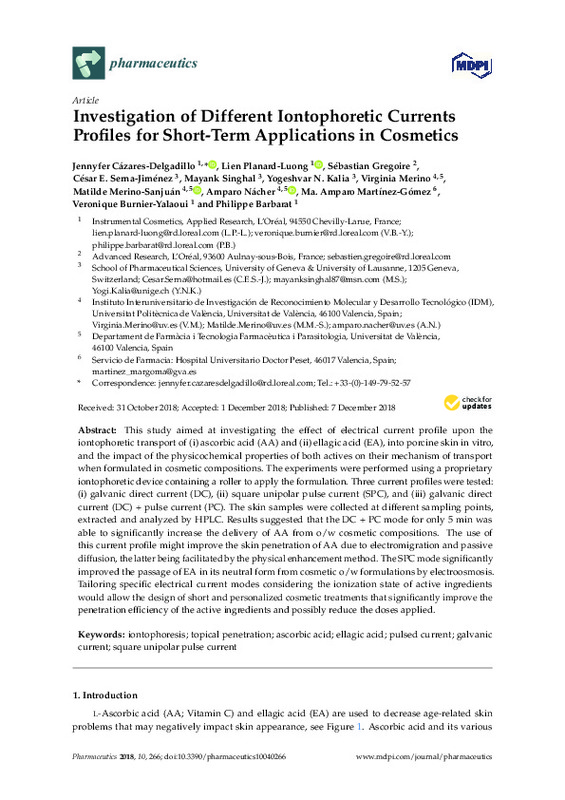JavaScript is disabled for your browser. Some features of this site may not work without it.
Buscar en RiuNet
Listar
Mi cuenta
Estadísticas
Ayuda RiuNet
Admin. UPV
Investigation of Different Iontophoretic Currents Profiles for Short-Term Applications in Cosmetics
Mostrar el registro sencillo del ítem
Ficheros en el ítem
| dc.contributor.author | Cázares-Delgadillo, J.
|
es_ES |
| dc.contributor.author | Planard-Luong, L.
|
es_ES |
| dc.contributor.author | Gregoire, S.
|
es_ES |
| dc.contributor.author | Serna-Jiménez, C. E.
|
es_ES |
| dc.contributor.author | Singhal, Mayank
|
es_ES |
| dc.contributor.author | Kalia, Yogeshvar N.
|
es_ES |
| dc.contributor.author | Merino Sanjuán, Virginia
|
es_ES |
| dc.contributor.author | Merino sanjuán, Matilde
|
es_ES |
| dc.contributor.author | Nacher Alonso, Amparo
|
es_ES |
| dc.contributor.author | Martinez-Gomez, M. A.
|
es_ES |
| dc.contributor.author | Burnier-Yalaoui, V.
|
es_ES |
| dc.contributor.author | Barbarat, P.
|
es_ES |
| dc.date.accessioned | 2020-01-09T21:00:49Z | |
| dc.date.available | 2020-01-09T21:00:49Z | |
| dc.date.issued | 2018 | es_ES |
| dc.identifier.uri | http://hdl.handle.net/10251/134139 | |
| dc.description.abstract | [EN] This study aimed at investigating the effect of electrical current profile upon the iontophoretic transport of (i) ascorbic acid (AA) and (ii) ellagic acid (EA), into porcine skin in vitro, and the impact of the physicochemical properties of both actives on their mechanism of transport when formulated in cosmetic compositions. The experiments were performed using a proprietary iontophoretic device containing a roller to apply the formulation. Three current profiles were tested: (i) galvanic direct current (DC), (ii) square unipolar pulse current (SPC), and (iii) galvanic direct current (DC) + pulse current (PC). The skin samples were collected at different sampling points, extracted and analyzed by HPLC. Results suggested that the DC + PC mode for only 5 min was able to significantly increase the delivery of AA from o/w cosmetic compositions. The use of this current profile might improve the skin penetration of AA due to electromigration and passive diffusion, the latter being facilitated by the physical enhancement method. The SPC mode significantly improved the passage of EA in its neutral form from cosmetic o/w formulations by electroosmosis. Tailoring specific electrical current modes considering the ionization state of active ingredients would allow the design of short and personalized cosmetic treatments that significantly improve the penetration efficiency of the active ingredients and possibly reduce the doses applied. | es_ES |
| dc.description.sponsorship | This research was entirely funded by L'Oreal, France. | es_ES |
| dc.language | Inglés | es_ES |
| dc.publisher | MDPI AG | es_ES |
| dc.relation.ispartof | Pharmaceutics | es_ES |
| dc.rights | Reconocimiento (by) | es_ES |
| dc.subject | Iontophoresis | es_ES |
| dc.subject | Topical penetration | es_ES |
| dc.subject | Ascorbic acid | es_ES |
| dc.subject | Ellagic acid | es_ES |
| dc.subject | Pulsed current | es_ES |
| dc.subject | Galvanic current | es_ES |
| dc.subject | Square unipolar pulse current | es_ES |
| dc.title | Investigation of Different Iontophoretic Currents Profiles for Short-Term Applications in Cosmetics | es_ES |
| dc.type | Artículo | es_ES |
| dc.identifier.doi | 10.3390/pharmaceutics10040266 | es_ES |
| dc.rights.accessRights | Abierto | es_ES |
| dc.contributor.affiliation | Universitat Politècnica de València. Instituto de Reconocimiento Molecular y Desarrollo Tecnológico - Institut de Reconeixement Molecular i Desenvolupament Tecnològic | es_ES |
| dc.description.bibliographicCitation | Cázares-Delgadillo, J.; Planard-Luong, L.; Gregoire, S.; Serna-Jiménez, CE.; Singhal, M.; Kalia, YN.; Merino Sanjuán, V.... (2018). Investigation of Different Iontophoretic Currents Profiles for Short-Term Applications in Cosmetics. Pharmaceutics. 10(4). https://doi.org/10.3390/pharmaceutics10040266 | es_ES |
| dc.description.accrualMethod | S | es_ES |
| dc.relation.publisherversion | https://doi.org/10.3390/pharmaceutics10040266 | es_ES |
| dc.description.upvformatpinicio | 266 | es_ES |
| dc.type.version | info:eu-repo/semantics/publishedVersion | es_ES |
| dc.description.volume | 10 | es_ES |
| dc.description.issue | 4 | es_ES |
| dc.identifier.eissn | 1999-4923 | es_ES |
| dc.relation.pasarela | S\383213 | es_ES |
| dc.contributor.funder | L'Oréal | |
| dc.description.references | R. Hamad, A.-W., Al-Momani, W. M., Janakat, S., & A. Oran, S. (2009). Bioavailability of Ellagic Acid After Single Dose Administration Using HPLC. Pakistan Journal of Nutrition, 8(10), 1661-1664. doi:10.3923/pjn.2009.1661.1664 | es_ES |
| dc.description.references | Kalia, Y. N., Naik, A., Garrison, J., & Guy, R. H. (2004). Iontophoretic drug delivery. Advanced Drug Delivery Reviews, 56(5), 619-658. doi:10.1016/j.addr.2003.10.026 | es_ES |
| dc.description.references | Marro, D., Kalia, Y. N., Begoña Delgado‐Charro, M., & Guy, R. H. (2001). Pharmaceutical Research, 18(12), 1701-1708. doi:10.1023/a:1013318412527 | es_ES |
| dc.description.references | Sobhi, R. M., & Sobhi, A. M. (2012). A single-blinded comparative study between the use of glycolic acid 70% peel and the use of topical nanosome vitamin C iontophoresis in the treatment of melasma. Journal of Cosmetic Dermatology, 11(1), 65-71. doi:10.1111/j.1473-2165.2011.00599.x | es_ES |
| dc.description.references | Hori, Y., Akimoto, R., Hori, A., Kato, K., Chino, D., Matsumoto, S., … Watanabe, Y. (2010). Skin collagen reproduction increased by ascorbic acid derivative iontophoresis by frequent-reversal bipolar electric stimulation. International Journal of Cosmetic Science, 32(3), 234-234. doi:10.1111/j.1468-2494.2010.00577_3.x | es_ES |
| dc.description.references | Junyaprasert, V. B., Singhsa, P., Suksiriworapong, J., & Chantasart, D. (2012). Physicochemical properties and skin permeation of Span 60/Tween 60 niosomes of ellagic acid. International Journal of Pharmaceutics, 423(2), 303-311. doi:10.1016/j.ijpharm.2011.11.032 | es_ES |
| dc.description.references | Maia, A. M., Baby, A. R., Pinto, C. A. S. O., Yasaka, W. J., Suenaga, E., Kaneko, T. M., & Velasco, M. V. R. (2006). Influence of sodium metabisulfite and glutathione on the stability of vitamin C in O/W emulsion and extemporaneous aqueous gel. International Journal of Pharmaceutics, 322(1-2), 130-135. doi:10.1016/j.ijpharm.2006.05.038 | es_ES |








